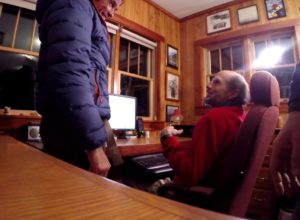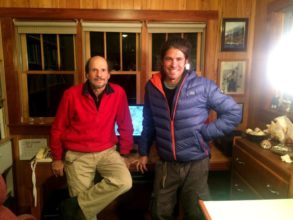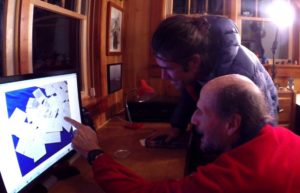In 2016 I had the chance to visit Steven Callahan at his home in Maine (USA) and get to know more about his SOLO castaway experience at sea. He survived for 76 days adrift on the Atlantic Ocean in a liferaft.
 When I have some time, I will try to make a story about this fascinating person. As he is boat engineer and survival at sea expert, he designed the FRIB (folding rigid-bottomed inflatable boat) which seems to be the perfect and revolutionary liferaft, instead of the classic inflatable liferaft. You can find out more about his invention on his website.
When I have some time, I will try to make a story about this fascinating person. As he is boat engineer and survival at sea expert, he designed the FRIB (folding rigid-bottomed inflatable boat) which seems to be the perfect and revolutionary liferaft, instead of the classic inflatable liferaft. You can find out more about his invention on his website.
I recommend buying the book of his amazing adventure on Amazon.
In the meantime I’ve copied/pasted the post of Steve from Wikipedia:
Steven Callahan (born 1952) is an American author, naval architect, inventor and sailor noted for having survived for 76 days adrift on the Atlantic Ocean in a liferaft. Callahan recounted his ordeal in the best-selling memoir Adrift: 76 Days Lost At Sea (1986), which was on The New York Times best-seller list for more than 36 weeks.
Callahan departed Newport, Rhode Island, United States, in 1981 on the Napoleon Solo, a 6.5-meter sloop he designed and built himself, single-handedly sailed the boat to Bermuda. In a growing gale, seven days out, his vessel was badly holed by an unknown object during a night storm, and became swamped, although it did not sink outright due to watertight compartments Callahan had designed into the boat. In his book, Callahan writes that he suspects the damage occurred from a collision with a whale.
Unable to stay aboard Napoleon Solo as it filled with water and was overwhelmed by breaking seas, Callahan escaped into a six-person Avon inflatable life raft, measuring about six feet across. He stood off in the raft, but managed to get back aboard several times to dive below and retrieve a piece of cushion, a sleeping bag, and an emergency kit containing, among other things, some food, navigation charts, a short spear gun, flares, torch, solar stills for producing drinking water and a copy of a survival manual. Before dawn, a big breaking sea parted the life raft from Napoleon Solo and Callahan drifted away.[3]
The raft drifted westward with the South Equatorial Current and the trade winds. After exhausting the meager food supplies he had salvaged from the sinking sloop, Callahan survived by “learning to live like an aquatic caveman.” He ate primarily mahi-mahi as well as triggerfish, which he speared, along with flying fish, barnacles, and birds that he captured. The sea life was all part of an ecosystem that evolved and followed him for 3,300 km across the ocean. He collected drinking water from two solar stills and various jury-rigged devices for collecting rainwater, which together produced on average just over a pint of water per day.
Callahan’s use of an EPIRB (Emergency Position Indicating Radio Beacon) and many flares did not trigger a rescue. EPIRBs were not monitored by satellites at the time, and he was in too empty a part of the ocean to be heard by aircraft. Ships did not spot his flares. While adrift, he spotted nine ships, most in the two sea lanes he crossed, but from the beginning, Callahan knew that he could not rely upon rescue but instead must, for an undetermined time, rely upon himself and maintaining a shipboard routine for survival. He routinely exercised, navigated, prioritized problems, made repairs, fished, improved systems, and built food and water stocks for emergencies.
On the eve of April 20, 1982, he spotted lights on the island of Marie Galante, south east of Guadeloupe. The next day, on Callahan’s 76th day afloat in the raft, fishermen picked him up just offshore, drawn to him by birds hovering over the raft, which were attracted by the ecosystem that had developed around it. During the ordeal, he faced sharks, raft punctures, equipment deterioration, physical deterioration, and mental stress. Having lost a third of his weight and being covered with scores of saltwater sores, he was taken to a local hospital for an afternoon, but left that evening and spent the following weeks recovering on the island and while hitchhiking on boats up through the West Indies.
During his journey, Callahan experienced a few positive elements aside from suffering, describing the night sky at one point as “A view of heaven from a seat in hell.” He still enjoys sailing and the sea, which he calls the world’s greatest wilderness. Since his survival drift, he’s made dozens of additional offshore passages and ocean crossings, most of them with no more than two other crew.
This incident is featured on the I Shouldn’t Be Alive episode “76 Days Adrift”. Callahan’s story also featured on an episode of British Survival expert Ray Mears Television series Extreme Survival.
In the making of the 2012 movie Life of Pi, director Ang Lee asked Callahan to be a consultant on living aboard a life raft. Ang Lee told Callahan, “I want to make the ocean a real character in this movie”. Callahan made lures and other tools seen in the movie.[4]
FOLLOW OUR CASTAWAY STORIES ON INSTAGRAM
FOLLOW OUR CASTAWAY STORIES ON FACEBOOK
FOLLOW OUR CASTAWAY STORIES ON YOUTUBE
—




{ 0 comments… add one now }